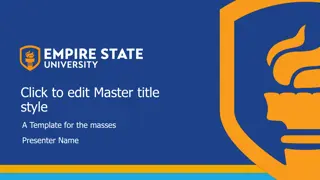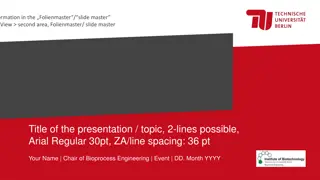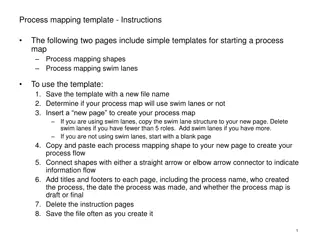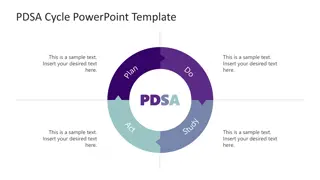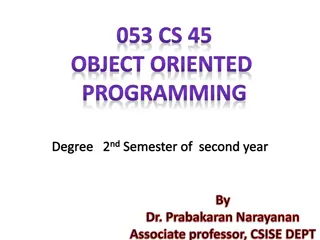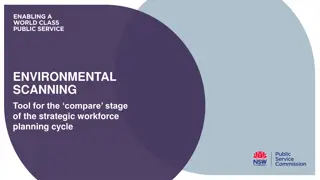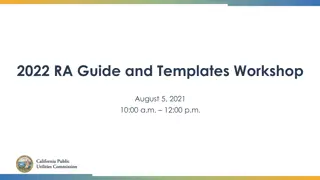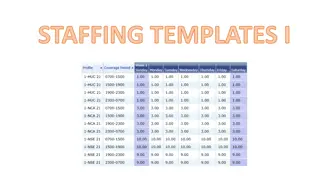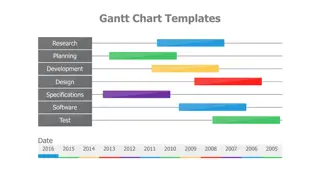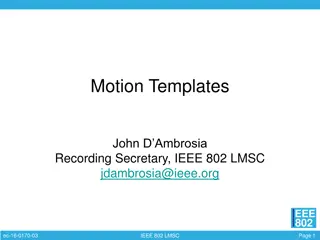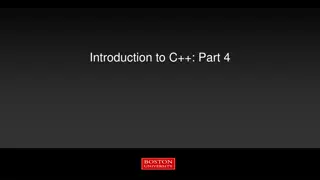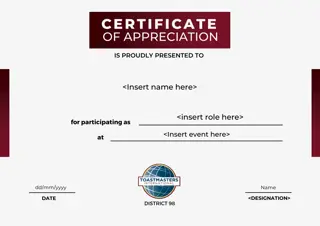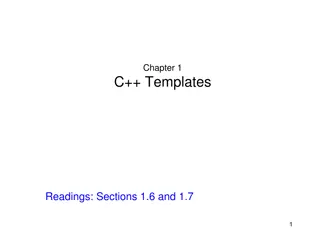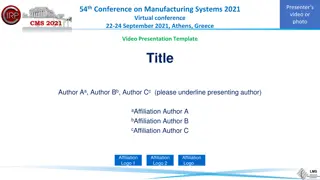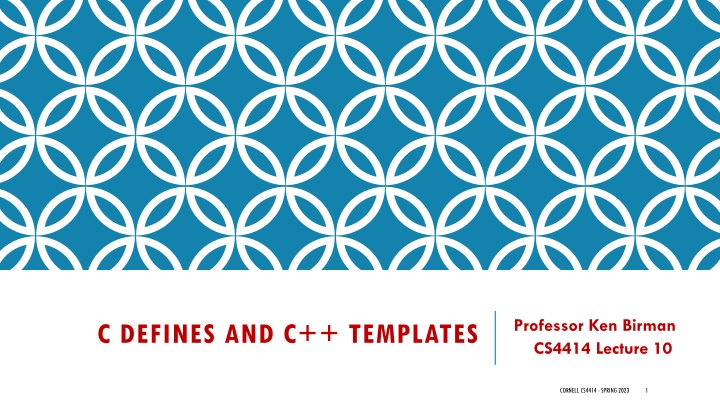
Evolution of C++ Templates: From History to Powerful Programming Tool
Delve into the evolution of C++ templates, exploring their significance in compile-time computing and the benefits they offer over Java generics. Discover how templates in C++ provide a powerful tool for programming the compiler and optimizing system performance. Uncover the history and concept of generics and templates, highlighting their role in enhancing code efficiency and maintainability.
Download Presentation

Please find below an Image/Link to download the presentation.
The content on the website is provided AS IS for your information and personal use only. It may not be sold, licensed, or shared on other websites without obtaining consent from the author. If you encounter any issues during the download, it is possible that the publisher has removed the file from their server.
You are allowed to download the files provided on this website for personal or commercial use, subject to the condition that they are used lawfully. All files are the property of their respective owners.
The content on the website is provided AS IS for your information and personal use only. It may not be sold, licensed, or shared on other websites without obtaining consent from the author.
E N D
Presentation Transcript
Professor Ken Birman CS4414 Lecture 10 C DEFINES AND C++ TEMPLATES CORNELL CS4414 - SPRING 2023 1
COMPILE TIME COMPUTING In lecture 9 we learned about const, constexpr and saw that C++ really depends heavily on these Ken s solution to word count runs about 10% faster with extensive use of these annotations Constexpr underlies the auto keyword and can sometimes eliminate entire functions by precomputing their results at compile time. Parallel C++ code would look ugly without normal code structuring. Const and constexpr allow the compiler to see beyond that and recognize parallelizable code paths. CORNELL CS4414 - SPRING 2023 2
BUT HOW FAR CAN WE TAKE THIS IDEA? Today we will look at the concept of programming the compiler using the templating layer of C++ We will see that it is a powerful tool! There are also programmable aspects of Linux, and of the modern hardware we use. By controlling the whole system, we gain speed and predictability while writing elegant, clean code. CORNELL CS4414 - SPRING 2023 3
IDEA MAP FOR TODAY History of generics: #define in C Templates are easy to create, if you stick to basics The big benefit compared to Java is that a template is a compile-time construct, whereas in Java a generic is a run-time construct. We have seen a number of parameterized types in C++, like std::vector and std::map The template language is Turing-complete, but computes only on types, not data from the program (even when constants are provided). These are examples of templates . They are like generics in Java CORNELL CS4414 - SPRING 2023 4
WE ARE GOING TO BRIEFLY STEP BACKWARDS IN TIME In the Monday lecture we already started to see templates and auto and const/constexpr. Put that to the side for a moment. To see how templates evolved in the form they have in C++, it makes sense to trace the history of their evolution. This will take us back to the pre-C++ era, for a few slides. CORNELL CS4414 - SPRING 2023 5
CONCEPT OF A GENERIC OR TEMPLATE A class that can be specialized by providing element types as class arguments. For example, a list of pets or a map from strings to counters This separates the abstraction the class implements from the specific types of objects it manages. CORNELL CS4414 - SPRING 2023 6
EARLY HISTORY OF GENERICS Many trace their roots to C, the original language introduced with Unix (which was the original Linux) C++ still has C as a subset C++ will compile a C program. But C lacked classes, so object oriented coding was infeasible CORNELL CS4414 - SPRING 2023 7
C FILE INCLUSION #include file . This says track down the file, and substitute its contents into my code at this spot. There are two notations: filename and <filename>. The one with quotes searches for that exact file. The < > notation is for predefined C++ headers or C headers. With < > often you don t even need to specify .h versus .hpp CORNELL CS4414 - SPRING 2023 8
C MACRO SUBSTITUTION The most basic option just defines a replacement rule: #define SOMETHING something-else But this wasn t enough, and people added parameters #define SOMETHING(x) something-else that uses x CORNELL CS4414 - SPRING 2023 9
EXAMPLES Examples using #define #define OPT1 0x00001 #define MAXD 1000 #define SIGN(x) (x < 0: -1: 1) #define ERRMSG(s) { if(DEBUGMODE) printf(s); } CORNELL CS4414 - SPRING 2023 10
ONE USE OF #DEFINE(T) WAS FOR TYPES Allows a library method to be specialized for a single type. But C code gets confusing if #define(T) is respecialized for multiple uses in different places. There is a way to redefine a # define, like first have T be Pets and then later have it be Deserts, but it leads to strange bugs CORNELL CS4414 - SPRING 2023 11
OTHER ADVANCED FEATURES OF C PREPROCESSORS #if, #else/#elif, #endif offer some limited compile-time control. The dead code vanishes, and the compiler never even sees it. Typical uses: compile one version of the code if the computer has a GPU, a different version if it lacks a GPU. Or have debugging logic that vanishes when we aren t testing. CORNELL CS4414 - SPRING 2023 12
BUT THEY ARE TOO LIMITED As noted, we couldn t create a type that can be parameterized with types of objects using it, or that it holds. And we can t reason about types in #if statements, which have very limited conditional power. All of these limitations frustrated C users. CORNELL CS4414 - SPRING 2023 13
WHILE ALL OF THIS WAS PLAYING OUT, LANGUAGES BECAME OBJECT ORIENTED Java was the first widely successful OO language, but in fact there were many prior attempts. Java used pragmas and annotations for some roles similar to what C did with #define, #if, etc. A very large community began to use objects but early decisions resulted in runtime reflection overheads (discussed previously)! CORNELL CS4414 - SPRING 2023 14
JAVA POLYMORPHISM Allows a single method with a single name to have varying numbers of arguments, and varying argument types. The compiler had the task of matching each invocation to one of the polymorphic variants. CORNELL CS4414 - SPRING 2023 15
JAVA GENERICS In the early versions of Java, a class such as list or a hash map would just treat the values as having object type . This, though, is impossible to type check: is this a list that only includes animals that can bark, or might it also have other kinds of animals on it, or even non-animals? Java generics solved that problem, but Java retained the older form of unresolved object types as a form of legacy. CORNELL CS4414 - SPRING 2023 16
THE POWER OF GENERICS In fact Java s generics are amazingly powerful. You can literally load a Java JAR file, see if it implements class List with objects that all support operations Bark, Sit, LieDown, etc, and if so, call them. This is done using runtime reflection in which a program can take a reference to a class (even one loaded from a JAR file) and enumerate over the variables, types and methods it defines CORNELL CS4414 - SPRING 2023 17
THE ISSUE WITH JAVA GENERICS The language never eliminated the universal object class, which is the common supertype for all the more specific Java classes. As a result, Java needed an instanceof test, as well as other features, so that the runtime can figure out what types of objects it is looking at (for runtime type checking) and also which method to call (for polymorphic method invocations) CORNELL CS4414 - SPRING 2023 18
C++ TEMPLATE GOALS When C++ was designed, the owners of its template architecture were aware of the C and Java limitations. They wanted to find a pure way to express the same concepts while also programming in an elegant, self-explanatory way, and they wanted to do this without loss of performance. CORNELL CS4414 - SPRING 2023 19
TEMPLATES AND POLYMORPHISM IN C++ Polymorphic method calls, but resolved at compile time. Extensible classes, but flexible and able to look at object types and generate different logic for different types. C++ lacks the equivalent of the Java run-time instanceof . It does have a compile-time instanceof. In C++ all types are fully resolved at compile time. Every C++ object has a single and very specific type CORNELL CS4414 - SPRING 2023 20
TEMPLATES AND POLYMORPHISM IN C++ in fact, even polymorphism in C++ is resolved at compile time! C++ is always able to identify the specific method instance to call. C++ even dynamically loads libraries without worrying that somehow the library methods won t be what it expects. CORNELL CS4414 - SPRING 2023 21
TEMPLATES AND POLYMORPHISM IN C++ but there is one powerful feature that is very much like runtime polymorphism: inheritance of fully virtual classes In C++ we often define a virtual class that describes a standard set of methods shared across some set of different classes. So for example, IBark could be an interface shared by animals that know how to bark , with a method bark . CORNELL CS4414 - SPRING 2023 22
INTERFACE CLASSES IN C++ For example: class line : public shape { public: virtual ~line(); virtual void move_x(int x); // implements move_x virtual void move_y(int y); // implements move_y virtual void draw(); // implements draw private: point end_point_1, end_point_2; //... }; class shape // An interface class { public: virtual ~shape(); virtual void move_x(int x) = 0; virtual void move_y(int y) = 0; virtual void draw() = 0; //... }; CORNELL CS4414 - SPRING 2023 23
INTERFACE CLASSES IN C++ IShape but in fact, there is no rule Some developers prefer names like Says that any class inheriting the shape interface must define this method. For example: Tells C++ that this is supposed to match a virtual method inherited from some other class (in our case, from shape ) class line : public shape { public: virtual ~line(); virtual void move_x(int x); // implements move_x virtual void move_y(int y); // implements move_y virtual void draw(); // implements draw private: point end_point_1, end_point_2; //... }; class shape // An interface class { public: virtual ~shape(); virtual void move_x(int x) = 0; virtual void move_y(int y) = 0; virtual void draw() = 0; //... }; We are looking at line.hpp, which has the type signature but not the implementation. Line.cpp is required to implement line::move_x(int x), etc. CORNELL CS4414 - SPRING 2023 24
THESE FULLY VIRTUAL CLASSES ARE INHERITED BY CONCRETE CLASSES A class like Dog would inherit a fully virtual class like IBark. Dog is required to provide implementations (code bodies) for the virtual IBark methods that had = 0. CORNELL CS4414 - SPRING 2023 25
YOU CAN TEMPLATE AN INTERFACE! The syntax is just like a template for any other class. This allows a very powerful form of runtime polymorphism CORNELL CS4414 - SPRING 2023 26
TEMPLATES ALSO HAVE A FORM OF COMPILE- TIME INSTANCEOF FEATURE You can check to see if a type has some specific characteristic and generate code conditional on that. For example, a template could check to see if the given type supports IBark and if so, call the bark method. But then if not, it could check for IPurr. And then for IChirp This all occurs when the template is instantiated at compile time CORNELL CS4414 - SPRING 2023 27
HOW WOULD WE USE THIS? One use is to create a template that treats native types differently than class types and structs Template code can also emit type-specific C++ logic, and we will see this when we look at printf in a few minutes CORNELL CS4414 - SPRING 2023 28
C++ TEMPLATES Botton line: they can do everything Java generics can do, but at compile time, and also cover defines, varargs, etc. We will start with simpler cases that you might often want to use, then will just skim the fancier things seen in C++ libraries, but that normal mortals don t normally need to actually do. CORNELL CS4414 - SPRING 2023 29
SUMMARY OF TEMPLATE GOALS Compile time type checking and type-based specialization. A way to create classes that are specialized for different types Conditional compilation, with dead code automatically removed Code polymorphism and varargs without runtime polymorphism CORNELL CS4414 - SPRING 2023 30
C++ ADVANTAGE? It centers on the compile-time type resolution. Impact? The resulting code is blazingly fast. In fact, C++ wizards talk about the idea that at runtime, all the fancy features are gone, and we are left with plain old data and logic that touches that data mapped to a form of C. The job of C++ templates is to be as expressive as possible without ever requiring any form of runtime reflection. CORNELL CS4414 - SPRING 2023 31
THE BASIC IDEA IS EXTREMELY SIMPLE As a concept, a template could not be easier to understand. Suppose we have an array of objects of type int: int myArray[10]; With a template, the user supplies a type by coding something like Things<long>. Internally, the class might say something like: template<Typename T> T myArray[10]; CORNELL CS4414 - SPRING 2023 32
THE BASIC IDEA IS EXTREMELY SIMPLE As a concept, a template could not be easier to understand. Suppose we have an array of objects of type int: int myArray[10]; With a template, the user supplies a type (T) and we express this by just coding: T myArray[10]; T behaves like a variable, but the value is some type, like int or Bignum CORNELL CS4414 - SPRING 2023 33
YOU CAN ALSO TEMPLATE A CLASS template<typename T> class Things { T myArray[10]; T getElement(int); void setElement(int,T); } CORNELL CS4414 - SPRING 2023 34
AND CAN EVEN SUPPLY A CONSTANT template<class T, const int NElems> class Things { T myArray[NElems]; T getElement(int); void setElement(int,T); } CORNELL CS4414 - SPRING 2023 35
TEMPLATED FUNCTIONS Templates can also be associated with individual functions. The entire class can have a type parameter, but a function can have its own (perhaps additional) type parameters This really should require that T be a type supporting comparable . We ll see how to specify that restriction in a moment. Template<typename T> T max(T a, T b) { return a>b? a : b; // T must support a > b } CORNELL CS4414 - SPRING 2023 36
FUNCTION TEMPLATES Nothing special has to be done to use a function template int main(int argc, char* argv[]) { int a = 3, b = 7; double x = 3.14, y = 2.71; } cout << max(a, b) << endl; cout << max(x, y) << endl; cout << max(a, x) << endl; // Instantiated with type int // Instantiated with type double // ERROR: types do not match cout is templated. The type is automatically inferred by C++ CORNELL CS4414 - SPRING 2023 37
CLASS TEMPLATES template <class T> class myarray { private: T* v; int sz; public: myarray(int s) { v = new T [sz = s]; } // Constructor myarray(const myarray& b) { v = b.v; sz = b.sz; }// Copy constructor ~myarray() { delete[] v; } // Destructor T& operator[] (int i) { return v[i]; } size_t size() { return sz; } }; You can instantiate the same templated class with different types myarray<int> intArray(10); myarray<shape> shapeArray(10); CORNELL CS4414 - SPRING 2023 38
Developer of this class wanted T to be a class type (not a base type like int, double, etc) CLASS TEMPLATES template <class T> class myarray { private: T* v; int sz; public: myarray(int s) { v = new T [sz = s]; } // Constructor myarray(const myarray& b) { v = b.v; sz = b.sz; }// Copy constructor // Destructor Syntax is fine, but gives a compilation error: int is a type, but it is not a class type (not a C++ object) ~myarray() { delete[] v; } T& operator[] (int i) { return v[i]; } size_t size() { return sz; } }; You can instantiate the same templated class with different types myarray<int> intArray(10); myarray<shape> shapeArray(10); CORNELL CS4414 - SPRING 2023 39
TEMPLATE TYPES CAN BE CONSTRAINED Suppose that we want to build a template for a class with a method speak() that calls bark() . Dogs and seals bark. Cats do not. So we might want to restrict our template type: template<typename T> requires T instanceof(IBark) CORNELL CS4414 - SPRING 2023 40
TEMPLATE TYPES CAN BE CONSTRAINED We might even want to implement a given function in a different way for different types of objects. You could do this using instanceof inline in your code, but it is handled at compile time. This rule introduces some complications. C++ has many options; we will just look at one of them. See https://en.cppreference.com/w/cpp/language/constraints CORNELL CS4414 - SPRING 2023 41
REQUIRES This clause allows you to say that the template type must implement some interface. This says that the template is only valid for classes that define equality testing, or for types that are aliases of the void type. template<typename T> requires EqualityComparable<T> || Same<T, void> https://en.cppreference.com/w/cpp/language/constraints CORNELL CS4414 - SPRING 2023 42
FANCIER: A C++ TEMPLATED TYPE CONCEPT A concept is a compile-time type test, part of the templating language in C++. Useful in requires clauses. For type T, this example defines EqualityComparable to mean implements the operators == and != . template<typename T> concept EqualityComparable = requires(T a, T b) { { a == b } -> std::boolean; { a != b } -> std::boolean; }; CORNELL CS4414 - SPRING 2023 43
TYPEDEF Templated types with optional fields can become quite complicated. Typedef allows you to give a short name to a type that might otherwise require a long name. Examples: typedef vector<int> VecInt; typedef map<string, tuple<double, int, float, MyClass> > MyTuple; CORNELL CS4414 - SPRING 2023 44
THE MOST COMMON CASE FOR USING This keyword says that your code is importing names from a namespace or class that is already defined. For example using std would eliminate the need to write std::cout But Ken isn t fond of using for std:: or even for its members like std::map. Code can become confusing for a reader unfamiliar with the package you are using. CORNELL CS4414 - SPRING 2023 45
USING CAN ALSO PLAY THE ROLE OF TYPEDEF Syntax is using name = type; Often useful in a template! (1) template < template-parameter-list > // In an hpp file, common using name = type ; (2) using name = type ; // In a cpp file, deprecated But poor style to replace typedef with using in a cpp file. CORNELL CS4414 - SPRING 2023 46
VARIABLE ARGUMENT LISTS Methods with variable numbers of arguments are also a traditional source of confusion in strongly typed languages. In C, there are many methods like printf: printf( In zipcode %5d, today s high will be %5.1f\n , local_zipcode, local_temperature); notice that the format expects specific types of arguments! CORNELL CS4414 - SPRING 2023 47
VARARGS ARE HARD TO TYPE CHECK In Java, varargs can easily be supported using object type, and there are standard ways to iterate over the arguments supplied But this means we are forced to do runtime type checking later, when trying to do something to those objects, like convert to a string for printing. C++ wanted this same power with strong compile-time typing CORNELL CS4414 - SPRING 2023 48
IN C, THIS CAN SIMPLY RESULT IN BUGS If the temperature passed to this printf, in C, is of type int or some form of low-precision float type, printf will just print a nonsense output. The C++ designers wanted generics to also address this issue, and they came up with an insane concept (that works): one version of printf (or whatever) for every sequence of types actually used in the code. Polymorphism to the max! CORNELL CS4414 - SPRING 2023 49
WHAT??? Consider this case: printf( %d,%f,%d,%s\n , 2, 3.0, 4, 5.7 ); C has many other methods like this, including ones that arise in totally different situations (for example to handle networking addresses, which come in many flavors, like IPv4 versus IPv6). CORNELL CS4414 - SPRING 2023 50


